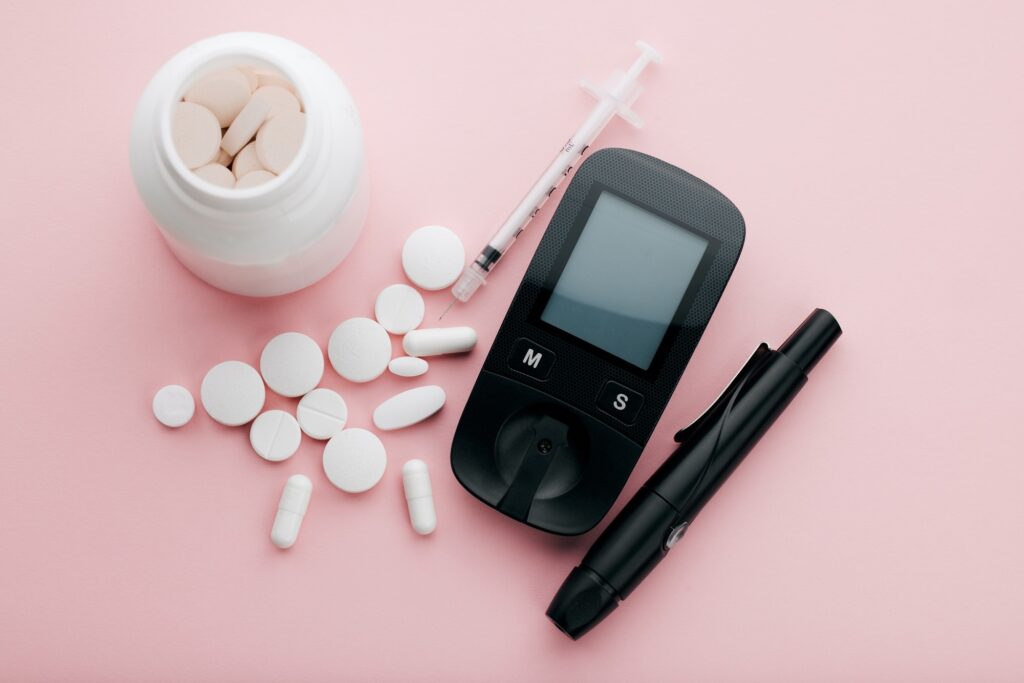
5 Menopause Support Complex Supplement to Help Ease Symptoms
Menopause support complexes are dietary supplements with herbal extracts and vitamins aimed at alleviating symptoms during menopause
healthy levels can seem easier said than done. It is often assumed that conventional medical advice can give the best results but there are surprisingly many natural ways to keep your blood sugar in a healthy range.
In this blog post, we’ll discuss the many natural ways you can maintain healthy blood sugar levels. We will cover the importance of diet, physical activity, lifestyle changes, supplements, and other natural interventions that can help you keep the levels that best support your health in check. We’ll also talk about natural approaches you can take to prevent and manage diabetes if you currently have the condition.
So let’s get started – if you’re ready for natural tips and tricks to achieve and maintain optimal blood sugar levels, read on!

Blood sugar, also known as either glucose or blood glucose, is the body’s primary source of energy. It is provided either naturally through food or through carbohydrates which get broken down and turn into sugar molecules to provide energy to the body. Glucose can be found in certain types of food such as fruits, grains, and dairy products. Keeping up with a healthy blood sugar level is essential for overall health, as high blood sugar levels can put a person at risk of developing type 2 diabetes and other metabolic diseases.
It has been suggested that, while some foods may be higher in carbohydrates than others, all carbohydrates nonetheless have an impact on raising blood sugar levels once ingested or digested. On the other hand, studies have shown that not all carbs are the same when it comes to raising blood sugar levels; for example, complex carbohydrates such as whole wheat bread and legumes have been seen to have less of an impact on glucose levels compared to simple carbs such as white bread. Furthermore, combining complex carbs with protein and healthy fats can also be beneficial in helping maintain healthy blood sugar levels.
It’s clear that getting enough nutrients from a balanced diet and understanding how different foods can affect our blood sugar levels is key when it comes to promoting good health. Now let us explore further how having a balanced nutrition plan along with healthy eating practices can help maintain adequate and balanced blood sugar levels over time.

Good nutrition and healthy eating practices are essential when it comes to understanding and managing blood sugar levels. A diet that is rich in whole foods such as fruits, vegetables, nuts, seeds, and legumes, instead of highly refined processed foods with added sugar, will support adequate and balanced blood sugar levels. Eating regular meals throughout the day can also help to maintain normal levels without overly fluctuating. It is important to avoid skipping meals or snacking on sugary treats for quick energy boosts between meals.
At the same time, there has been an ongoing debate about how much carbohydrates should be consumed to keep stabilizing the blood glucose levels. There are multiple evidence-based benefits of diets that are low in carbohydrates and high in fat content like the keto diet, whereas a diet higher in carbohydrates but lower in fat content is recommended by some nutritionists. One study found that low-carbohydrate eating practices typically resulted in improved glycemic control as compared to a more traditional higher starch, lower fat diet. Therefore, opting for a balanced macro-nutritional approach while following an individual’s lifestyle results in better glycemic control.
It is important to note that healthy eating practices should not be overly restrictive. Taking all symptoms into account such as weight loss or gain, insulin resistance, and chronic diseases should be taken into account before deciding on which dietary plan works best for each individual.
Regardless of the dietary approach chosen, incorporating an array of good quality fats from nuts and seeds, nutritious proteins from eggs and fish, fiber-rich non-starchy vegetables such as broccoli or spinach, and complex carbohydrates from legumes or grains are key for keeping healthy blood sugar levels. Learning what types of food provide the most benefit for your particular health needs is essential when it comes to managing your blood sugar levels naturally. As we delve deeper into the world of nutrition, dietary sources of carbohydrates and simple carbohydrates become more apparent and better understood.

Maintaining healthy blood sugar levels can be greatly impacted by the type of carbohydrates and glucose sources in our diet. According to the American Diabetes Association, limiting carbohydrates and increasing protein-rich foods can help manage blood sugar levels after meals. However, it is important to note that carbohydrates should not be eliminated from one’s diet. Carbohydrates are important for providing energy, as well as for the proper functioning of the body’s organs, muscles, and digestive system.
It is also essential to understand the difference between simple and complex carbohydrates. Simple carbohydrates provide just one (or two) saccharide molecules that are quickly metabolized into glucose, whereas complex carbohydrates are made up of three or more saccharide units linked together, and they often take longer to break down into simple sugars. Examples of dietary sources of simple carbohydrates include white bread, cereal, corn syrup, refined sugars, cakes, and pastries, while complex carbohydrate sources include historically whole grains such as oatmeal, quinoa, and brown rice; legumes such as beans and lentils; vegetables such as sweet potato and spinach; tree fruits (i.e., apples); and starchy vegetables such as corn.
Unlike complex carbohydrates that are slowly digested over time allowing a steady supply of energy throughout the day or night; simple carbohydrates can cause an immediate elevation in blood sugar levels followed by drops in energy once those stores have been depleted. For this reason, it may be best for people with diabetes to monitor their intake of simple sugars – though this should not suggest avoiding them altogether which could lead to a deficiency in essential nutrients required for healthy living including zinc and biotin.
Now that we have discussed different dietary sources of carbohydrate molecules – simple and complex – it is important to now discuss how foods are consumed throughout the day when attempting to maintain adequate blood sugar levels without peaks or troughs. Timing is essential for reaching personalized health goals, so let’s move on to look at effective strategies for meal timing and post-meal waiting periods.
The timing of food consumption is also important when it comes to maintaining healthy blood sugar levels. While dietary sources of carbohydrates are key, the timing of meals and snacks can also impact overall glucose levels. Some suggest that meal timing should take into consideration minimal post-meal waiting periods while others argue that frequent, smaller meals throughout the day is a better approach.
Evidence indicates that eating larger meals at breakfast and lunch, with a smaller dinner, improves overall glucose control. Eating these larger meals earlier in the day leaves time for digestion before bedtime which reduces the risk for elevated night-time glucose levels. In terms of post-meal waiting periods, some individuals with diabetes benefit from taking insulin shortly after eating to help manage glucose levels. However, this practice should always be coordinated with a physician as each individual’s response to insulin may differ.
By coordinating diet with meal times and controlling post-meal waiting periods, individuals can maintain more stable blood sugar levels throughout the day. As adjusting dietary practices and meal timing is often easier said than done, engaging in physical activity and exercise may also prove beneficial for attaining optimal healthful blood sugar levels.

The previous section discussed the importance of timing food consumption to maintain healthy blood sugar levels. Physical activity and exercise have also been proven to help establish optimal blood sugar levels. Exercise increases insulin sensitivity, which moves glucose from the bloodstream into muscle cells to be used as fuel. It can also lower cortisol levels, helping reduce stress and control cortisol levels which are a strong risk factor for diabetes. When engaging in physical activity, it is most effective when it takes place after eating meals with an emphasis on carbohydrates, as this results in higher insulin sensitivity during the recovery period.
Studies show that regular and consistent exercise brings about the greatest health benefit for people with diabetes compared to those who only exercise intermittently or not at all. Regular types of aerobic exercise like walking and running are best at helping to reduce high blood sugar levels, whereas resistance training has been shown to improve insulin sensitivity and encourage healthy glycemic levels. To maximize both safety and effectiveness in reducing elevated blood sugar levels, doctors recommend 30 minutes of aerobic activities five days a week along with two days of moderate resistance training.
It is important to note that individuals with pre-existing medical conditions should seek out advice from their healthcare provider before beginning any type of exercise program due to potential safety concerns. Additionally, individuals with diabetes requiring oral medication or insulin should be particularly careful while exercising and monitor glucose levels before, during, and after physical activity.
In conclusion, physical activity and exercise provide numerous benefits for those seeking to maintain healthy blood sugar levels in addition to proper meal timing discussed earlier. Therefore, incorporating regular physical activity should yield positive long-term effects on glycemic control and overall health. Coming up next we will discuss different types of physical activity recommended for achieving well-regulated blood sugar levels without overexertion or injury.
Physical activity plays an important role in maintaining healthy blood sugar levels. Exercise can help insulin work better by allowing the body’s cells to absorb glucose from the bloodstream more efficiently. Therefore, moderate to intense physical activity is necessary for people with diabetes or prediabetes to manage their blood sugar levels.
The best form of exercise for good blood sugar levels depends on individual needs and preferences as well as health status. Aerobic exercises are typically recommended because they improve cardiorespiratory fitness, which can help burn fat and improve overall health. However, this type of physical activity may not be suitable for everyone due to existing medical conditions or time constraints. Some experts argue that a combination of exercises, from low-intensity activities such as walking to high-intensity activities such as sprinting, is the most effective way to improve glycemic control.
Moreover, there is evidence that resistance training may help reduce levels of fasting insulin and raise glucose tolerance levels. In addition, strength training can lead to an increase in lean muscle mass which in turn can support improved glucose regulation in individuals with diabetes. This can be especially beneficial for those whose bodies have become less sensitive to insulin over time.
Regardless of what kind of exercise you decide to do, it should be part of a comprehensive plan that includes healthy eating habits and lifestyle changes. As you learn how to better manage your blood sugar levels naturally, it’s important to recognize that insulin plays a critical role in many metabolic processes throughout the body, and managing your insulin levels is key to overall health and well-being.

Having good control of both insulin levels and insulin resistance is essential for maintaining healthy blood sugar levels naturally. Insulin is the hormone that tells our cells to take in glucose, or sugar, from the bloodstream. So when we have too little or too much of it, this can cause our blood sugar levels to become out of balance.
On one hand, some research suggests that certain types of physical activity may help people to improve their control of insulin levels. Interval training, which involves short bursts of intense exercise interspersed with periods of active recovery, has been studied for its benefits for people with type 2 diabetes. In some studies, interval training was found to significantly improve insulin sensitivity and reduce fasting and postprandial glucose levels compared to not performing any physical activity at all. Similarly, moderate-intensity aerobic activity, such as brisk walking, has been shown in several studies to improve overall glycemic control by increasing insulin sensitivity and decreasing overall body fat and BMI (Body Mass Index).
On the other hand, it is also important to note that not every type of exercise can have a positive impact on insulin control. Some studies have found that while weight-bearing activities such as resistance training can improve muscle mass and strength, they are not as effective in reducing blood glucose and improving overall glycemic control. This is because such activities do not appear to lower overall body fat or increase insulin sensitivity like aerobic activity does.
Furthermore, if uncontrolled for too long, insulin resistance can eventually lead to type 2 diabetes. To prevent this from occurring, it is essential for individuals who may be at risk for developing type 2 diabetes to focus on both diet and regular physical activity. Eating a healthy and balanced diet with plenty of fresh fruits, vegetables, lean proteins, and whole grains can help keep blood sugar levels in check naturally. Additionally, being physically active regularly can help keep both insulin levels and insulin resistance under control as well.

Menopause support complexes are dietary supplements with herbal extracts and vitamins aimed at alleviating symptoms during menopause

Vitamin C, D3, Zinc, and Quercetin support immune health. They enhance immune cell function, fight infections, reduce inflammation, and provide antioxidant benefits.

Ginseng, a valued herb with adaptogenic and antioxidant properties, is popular as a supplement for improved well-being, energy, and immune function.

Nootropic supplements enhance focus, memory, and cognitive function. They boost mental clarity, motivation, and creativity for improved performance and brain health.

Garcinia cambogia, a tropical fruit, is touted for weight loss. Its active ingredient, HCA, may inhibit fat formation, but evidence is limited. Consult a professional before use.

More and more people are jumping on the mushroom supplement bandwagon these days, but you should be aware that there are potential side effects you should know about before taking the plunge. Whether you’re begging for overall well being or looking for an extra performance boost, you’re going to want to make sure you’re making an informed decision before adding mushroom supplements to your daily routine. We’ve put together a list of potential side effects to look out for, so read on and learn the truth before you start popping those pills.

Moringa, the “miracle tree,” offers numerous benefits. Moringa supplements provide essential nutrients, antioxidants, anti-inflammatory effects, and potential blood sugar and cholesterol regulation. They support immunity and combat malnutrition, but medical advice is essential.

It’s a good thing that Mother Nature both created and found cures for many of the ailments we humans suffer from. From the common cold to serious diseases, herbs have the potential to not only alleviate symptoms, but to completely prevent illnesses in the first place! Herbal remedies for immune system support have become increasingly popular as natural ways to boost your immunity against illness start to catch on.
